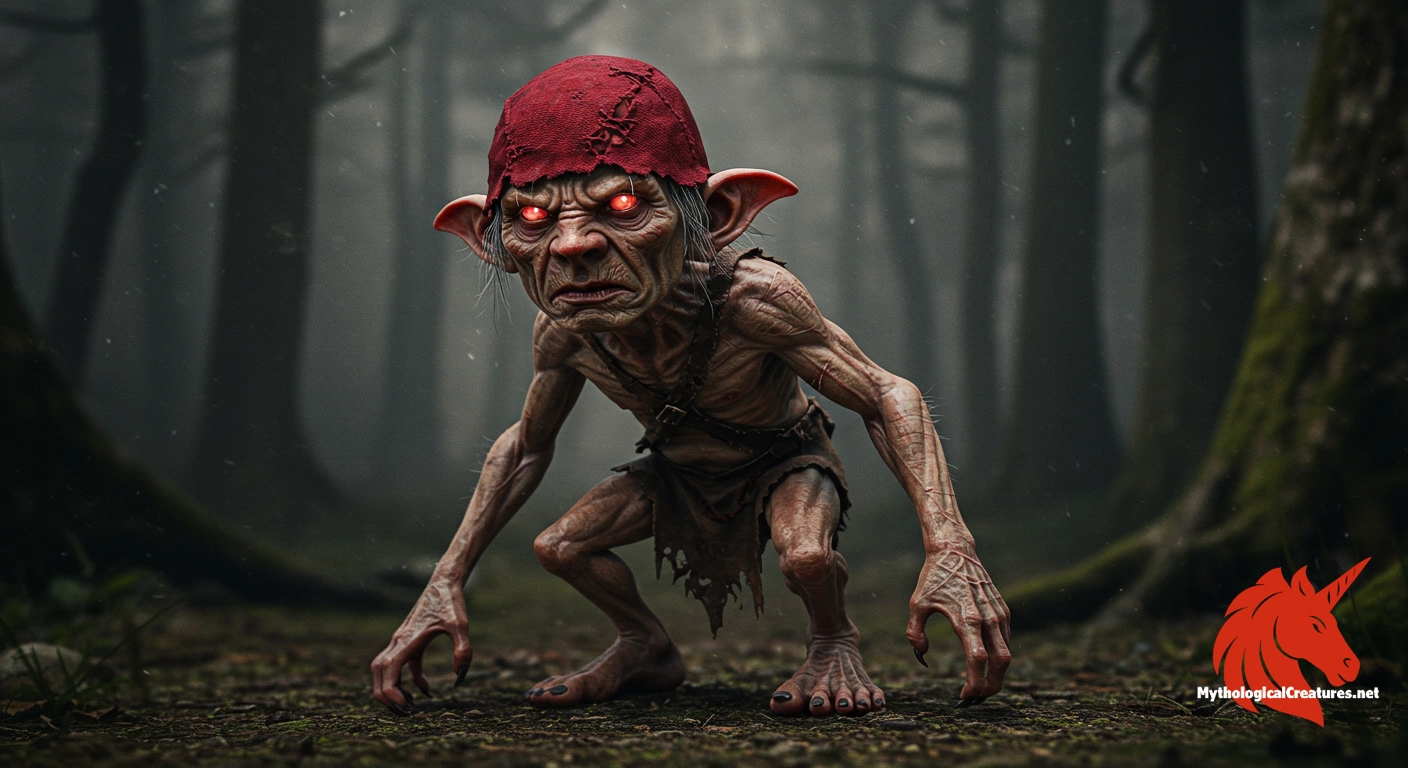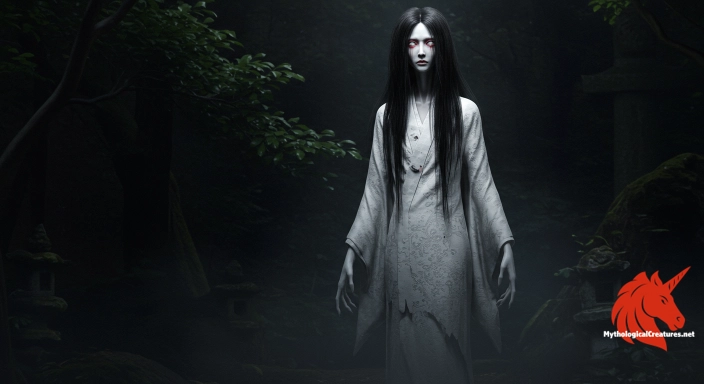Redcap: The Redcap is a malevolent goblin from Anglo-Scottish border folklore, notorious for soaking its cap in the blood of its victims.

Redcap
Redcap - Embodies the dark legacy of violent historical sites and serves as a grim warning in local folklore.
Origins & First Encounters
The legend of the redcap emerges from a tumultuous period along the Anglo-Scottish border, where history and myth intertwine in tales of bloodshed and retribution. The creature's origins are steeped in a landscape scarred by wars and tyrannical rule, leaving ruins that whisper of past atrocities. Born of the collective fears of communities living amidst constitutional strife, the redcap symbolizes the darker impulses of human actions. Its earliest attestations can be traced to oral traditions that have been passed down through generations, preserving narratives of its malevolent deeds. The redcap is depicted as a murderous goblin, notorious for staining his cap with the lifeblood of his victims. Over time, it gathered a rich and complex identity, reflected in its alternative names such as Powrie, Redcomb, and Bloody Cap, each highlighting a different facet of its grim nature. Local legends paint a picture of a relentless spirit inhabiting abandoned fortresses, each with its own history of cruelty. His enduring presence in folklore serves as both a cautionary tale and a chilling reminder of the violent past that haunts the borderlands.
Source Texts & Tale Variants
Early folklore, local ballads, and oral recountings have all contributed to the textured history of the redcap, ensuring that this figure remains a potent symbol of malice. Ancient texts from the border regions, though sparse, hint at the existence of similar malevolent beings and validate the redcap's feared reputation. Historians and folklorists have pieced together fragments from local traditions, noting how the redcap’s narrative has evolved over time. Variants of the story appear in Scottish romances and border broadsides, each adding layers of detail to the creature’s ominous character. Although no singular definitive source exists, each version reinforces the redcap's association with cursed sites and historic injustices. Some narratives describe him as a solitary spirit, while others integrate him into a larger tapestry of supernatural guardians of ruined castles. Despite the differing accounts, a consensus emerges about his blood-soaked cap and violent tendencies as primary attributes. These layered sources illustrate how folklore can serve as a living record of communal memory and social caution.
Form & Powers
The redcap is often depicted as a small, wiry goblin with a sinister, almost spectral appearance that belies his deadly nature. Descriptions abound about his signature red cap, which is macabrely stained with the blood of his victims, marking him as a creature of both violence and superstition. His eyes are frequently portrayed as gleaming with a feral light, and his features carved in a way that suggests both human cunning and animalistic brutality. Many accounts detail his sharp claws and elongated limbs, which allow him to scale ancient stone walls and vanish into the shadows with unnerving agility. His skin is sometimes described as weathered and almost reptilian in texture, echoing the decay of the ruins he inhabits. Though diminutive in size, redcap's agile frame and quick movements amplify his threat, making him an unpredictable and fearsome foe. Some folkloric portraits even hint at a subtle humanoid deformity, suggesting the creature's cursed transformation from man to monster. The physical traits of the redcap serve as a visual embodiment of the violent history and cursed energies that permeate his domain.
Regional Faces
Throughout the Anglo-Scottish borderlands, the redcap has taken on variations that reflect local histories and cultural nuances. In Scottish folklore, its presence at ancient, crumbling castles often carries the weight of historical injustices and familial feuds, while in bordering English regions, it intertwines with tales of haunted battlements and cursed estates. Many rural communities in these areas have incorporated the redcap into their local mythos, sometimes as a spectral warning against the perils of moral decay. The creature is occasionally attributed with a more mischievous side in certain local adaptations, though its underlying malevolence remains consistent across regional versions. Variations in visual description and behavioural details also appear, with some accounts portraying a leaner, almost shadow-like figure rather than a distinctly goblin form. Local adaptations sometimes merge the redcap with other eerie spirits or faerie beings, each contribution enriching its existing mythology. Despite these differences, regional narratives unanimously reinforce the notion of redcaps being tied to sites of historical cruelty and unsettled injustice. This regional diversity in storytelling highlights the adaptability of folklore, whereby a single creature can reflect the myriad experiences of communities living on the fringes of empire and order.
Cultural Parallels
In the broad landscape of European folklore, the redcap occupies a unique niche similar to other malevolent entities that serve as warnings and moral admonitions. Much like the goblins of Germanic lore or the mischievous yet dangerous sprites found in other Celtic traditions, the redcap embodies the chaotic forces born from human conflict. Its blood-soaked cap finds a parallel in other cultural depictions of cursed regalia or garments that symbolise violence and retribution. While many mythological beings are either protective faeries or benign tricksters, the redcap stands apart in his unrelenting malevolence and murderous tendencies. This creature’s association with ruined castles and battle-worn landscapes echoes the symbolism found in other borderland myths, where the environment itself seems imbued with the spirits of past transgressions. Comparative analysis shows that while entities like the Redcaps share overlapping characteristics with banshees or kobolds, they maintain distinct regional identities and narrative functions. The universal theme of vengeance arising from historical injustice is as relevant in the redcap’s myth as it is in other spectral legends across Europe. Such cross-cultural parallels underline a collective fascination with the idea that history’s dark deeds manifest in real, haunting forms. The redcap’s depiction, therefore, is not an isolated myth but part of a broader tapestry of human storytelling that spans continents and centuries.
Legacy & Modern Evolution
The legacy of the redcap has evolved significantly over the centuries, with its early role as a symbol of borderland violence expanding into a broader emblem of cursed history. Over time, collectors and writers of folklore have reimagined the redcap, cementing his place in modern myth as much more than a mere murderous goblin. As the fascination with gothic tales and haunted ruins grew in the 18th and 19th centuries, the redcap began to appear in literary works and local anecdotes that highlighted its eerie qualities. Contemporary art and popular culture have embraced the redcap, often incorporating it into modern fantasy settings and horror narratives that resonate with a sense of historical dread. Modern reinterpretations sometimes imbue the creature with tragic dimensions, suggesting a cursed existence born from relentless cruelty rather than a desire for destruction alone. Creative representations in films, video games, and graphic novels have updated the redcap's image, reflecting current sensibilities while preserving its connection to past injustices. The creature’s grim symbolism continues to inspire debates on morality and the legacy of historical violence in the border regions. Today, the redcap serves as a chilling reminder of how the echoes of tyranny and bloodshed can forge legends that endure well into contemporary times. His evolution from a local ghost story into a recognised icon of dark fantasy ensures that the redcap remains a dynamic and influential figure in both historical and modern cultural contexts.
Interesting Fact
An interesting aspect of the Redcap is its connection to actual historical sites of violence, which blurs the line between myth and history and lends a haunting credibility to its legend.
Quick Creature Info
Features:
Associations:
Our Mythic Legendary Rating:

Also Sometimes Known As:
Habitat:
Supernatural Powers:
Physical Attributes:
Abilities:
Behavior:
Lore:
References
Discover Another Mythical Legend You May Not Have Heard Of?
Uncover the mysteries of ancient folklore and expand your knowledge of legendary beings from cultures around the world.
Dare to Meet the Onryō....
Curated by the Mythological Creatures Team (rev. May 2025)
